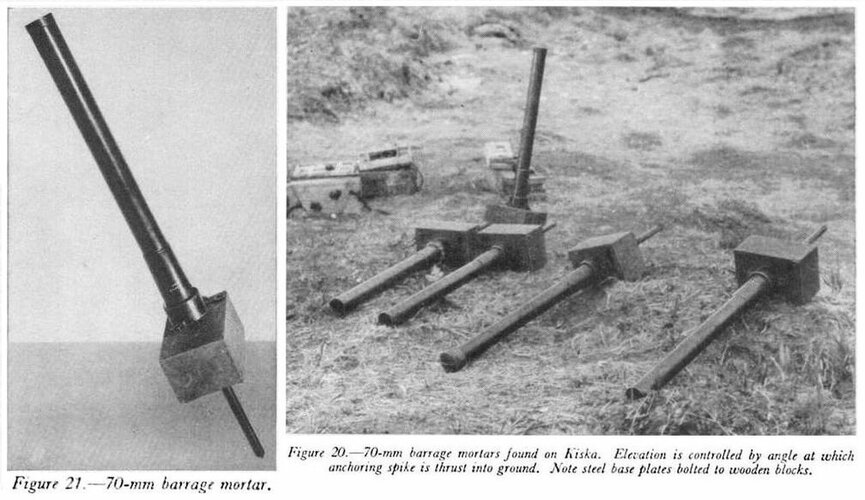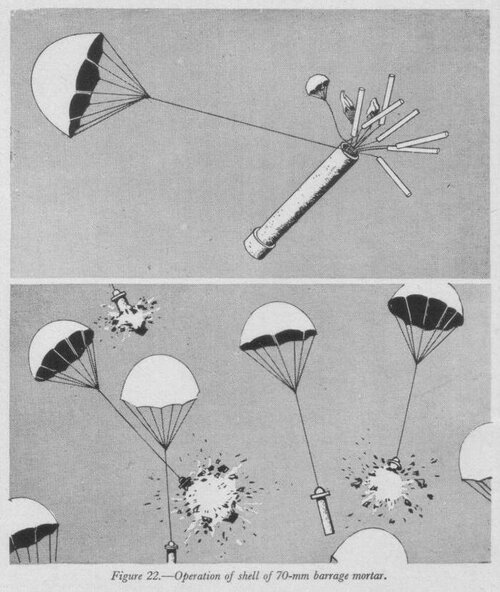klem
I really should change my personal text
- Joined
- 7 March 2015
- Messages
- 618
- Reaction score
- 1,248
" The Japanese 70-mm barrage mortar was first encountered on Attu. It consists of a smooth-bore tube, 4 feet long, the steel base plate of which is fastened by two bolts to a wooden block, 10 x 12 x 8 inches. A large iron spike on the under side of the wooden block is thrust into the ground to anchor the weapon, and the angle at which this is done controls elevation. The wooden block absorbs some of the shock of firing and prevents the mortar from embedding itself into the ground.
In addition to use against ground targets, the mortar has been employed as an antiaircraft weapon and is reported to have a maximum vertical range of approximately 4,000 feet. A curious mounting of the weapon in a Japanese plane also has been reported, with a plane of the "Dinah" type firing three rounds rearwards from a single mortar to ward off an attack by U. S. fighters. An 81-mm version of the weapon recently has been encountered, apparently designed for the same tactical use as the 70-mm model.
The shell which is fired by dropping it down the mortar tube contains seven parachute bombs, each 3 inches long and "'16 inch in diameter. The propellent charge ignites a delay powder train, which subsequently ignites an expelling charge within the shell when it reaches the standard altitude.
The expelling explosion causes the projection of the parachute bombs, each of which is supported by a rice-paper parachute. At the same time, a larger parachute opens, tilting the main container to ensure scattering of the seven bombs. The jerk caused by the opening of the bomb parachutes initiates the action of the detonating fuzes of the sensitive pull-igniter type, which are equipped with phosphorus-coated string and delay elements. The blast effect of the parachute bombs is severe, and the danger area is about 10 to 20 yards in radius.
Five rounds have been fired in a test, with the mortar at a 75-degree elevation. One round failed to eject the parachute bombs because of the malfunction of the delay-train ignition. The shells were quite noisy in flight and tumbled considerably, with the smoke of the black-powder delay train plainly visible. The releasing burst occurred in 7 to 8 seconds at altitudes of 1,520 to 1,660 feet, and the shell cases hit the ground close to the firing position. All inert components of the round drifted to the ground within 30 seconds, and the bombs drifted nearly a half mile, landing at intervals of about 30 yards.
Shells for the 81-mm barrage mortar recently were found on Leyte. An HE cylinder, attached to two parachutes, is propelled. A 45-second delay train is ignited in the shell which slowly descends. Detonation occurs after a fall of from 500 to 1,000 feet, or the shell may be exploded if a 33-foot cord attached to the igniter is struck by a plane".
Specifications are:
Total weight of shell : 3 lbs. 14 oz- Over-all length : 21.063 in - Diameter of shell body :1.496 in - Diameter of cylinder parachute : 11.968 in - Diameter ofigniter parachute : 15.984 in. (Integral text from "Japanese Mortars and Grenade Dischargers-Special Series N° 30 -15 March 1945. Military Intelligence Division-p.36.38.39")
In addition to use against ground targets, the mortar has been employed as an antiaircraft weapon and is reported to have a maximum vertical range of approximately 4,000 feet. A curious mounting of the weapon in a Japanese plane also has been reported, with a plane of the "Dinah" type firing three rounds rearwards from a single mortar to ward off an attack by U. S. fighters. An 81-mm version of the weapon recently has been encountered, apparently designed for the same tactical use as the 70-mm model.
The shell which is fired by dropping it down the mortar tube contains seven parachute bombs, each 3 inches long and "'16 inch in diameter. The propellent charge ignites a delay powder train, which subsequently ignites an expelling charge within the shell when it reaches the standard altitude.
The expelling explosion causes the projection of the parachute bombs, each of which is supported by a rice-paper parachute. At the same time, a larger parachute opens, tilting the main container to ensure scattering of the seven bombs. The jerk caused by the opening of the bomb parachutes initiates the action of the detonating fuzes of the sensitive pull-igniter type, which are equipped with phosphorus-coated string and delay elements. The blast effect of the parachute bombs is severe, and the danger area is about 10 to 20 yards in radius.
Five rounds have been fired in a test, with the mortar at a 75-degree elevation. One round failed to eject the parachute bombs because of the malfunction of the delay-train ignition. The shells were quite noisy in flight and tumbled considerably, with the smoke of the black-powder delay train plainly visible. The releasing burst occurred in 7 to 8 seconds at altitudes of 1,520 to 1,660 feet, and the shell cases hit the ground close to the firing position. All inert components of the round drifted to the ground within 30 seconds, and the bombs drifted nearly a half mile, landing at intervals of about 30 yards.
Shells for the 81-mm barrage mortar recently were found on Leyte. An HE cylinder, attached to two parachutes, is propelled. A 45-second delay train is ignited in the shell which slowly descends. Detonation occurs after a fall of from 500 to 1,000 feet, or the shell may be exploded if a 33-foot cord attached to the igniter is struck by a plane".
Specifications are:
Total weight of shell : 3 lbs. 14 oz- Over-all length : 21.063 in - Diameter of shell body :1.496 in - Diameter of cylinder parachute : 11.968 in - Diameter ofigniter parachute : 15.984 in. (Integral text from "Japanese Mortars and Grenade Dischargers-Special Series N° 30 -15 March 1945. Military Intelligence Division-p.36.38.39")


